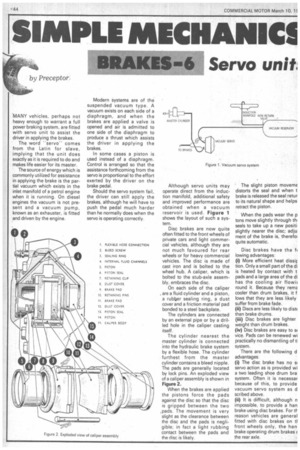SIMPLE MECHANICS
Page 46

If you've noticed an error in this article please click here to report it so we can fix it.
KES-6 Servo unit, by Preceptor
'MANY vehicles, perhaps not heavy enough to warrant a full power braking system, are fitted with servo unit to assist the driver in applying the brakes.
The word "servo" comes from the Latin for slave, implying that the unit does exactly as it is required to do and makes life easier for its master.
The source of energy which is commonly utilized for assistance in applying the brake is the partial vacuum which exists in the inlet manifold of a petrol engine when it is running. On diesel engines the vacuum is not present and a vacuum pump, known as an exhauster, is fitted and driven by the engine. Modern systems are of the suspended vacuum type. A vacuum exists on each side of a diaphragm, and when the brakes are applied a valve is opened and air is admitted to one side of the diaphragm to produce a thrust which assists the driver in applying the brakes.
In some cases a piston is used instead of a diaphragm. Control is arranged so that the assistance forthcoming from the servo is proportional to the effort exerted by the driver on the brake pedal.
Should the servo system fail, the driver can still apply the brakes, although he will have to push the pedal much harder than he normally does when the servo is operating correctly. Although servo units may operate direct from the induction manifold, additional safety and improved performance are obtained when a vacuum reservoir is used. Figure 1 shows the layout of such a system.
Disc brakes are now quite often fitted to the front wheels of private cars and light commercial vehicles, although they are not much favoured for rear wheels or for heavy commercial vehicles. The disc is made of cast iron and is bolted to the wheel hub. A caliper, which is bolted to the stub-axle assembly, embraces the disc.
On each side of the caliper are a fluid cylinder and a piston, a rubber sealing ring, a dust cover and a friction material pad bonded to a steel backplate.
The cylinders are connected by an external pipe or by a drilled hole in the caliper casting itself.
The cylinder nearest the master cylinder is connected into the hydraulic brake system by a flexible hose. The cylinder furthest from the master cylinder contains a bleed nipple. The pads are generally located by lock pins. An exploded view of a caliper assembly is shown in Figure 2.
When the brakes are applied the pistons force the pads against the disc so that the disc is gripped between the two , pads. The movement is very slight as the clearance between the disc and the pads is negligible; in fact a light rubbing contact between the pads and the disc is likely. • The slight piston moverne distorts the seal and when t brake is released the seal retur to its natural shape and helps retract the piston.
When the pads wear the p tons move slightly through th seals to take up a new positi slightly nearer the disc; adju ment of the brake is, there& quite automatic.
Disc brakes have the fi lowing advantages: (i) More efficient heat dissir tion. Only a small part of the di is heated by contact with t pads and a large area of the di has the cooling air Howl' round it. Because they remE cooler than drum brakes, it f lows that they are less likely suffer from brake fade.
(ii) Discs are less likely to dist( than brake drums.
(iii) Disc brakes are lighter weight than drum brakes.
(iv) Disc brakes are easy to SI vice. Pads can be renewed wi practically no dismantling of t system.
There are the following d advantages
(i) The disc brake has no SI servo action as is provided wi a two leading shoe drum bra system. Often it is necessar because of this, to provide vacuum servo system as d scribed above.
(ii) It is difficult, although n impossible, to provide a han brake using disc brakes. For tf reason vehicles are general fitted with disc brakes on tl front wheels only, the han brake operating drum brakes ( the rear axle.




















































































































